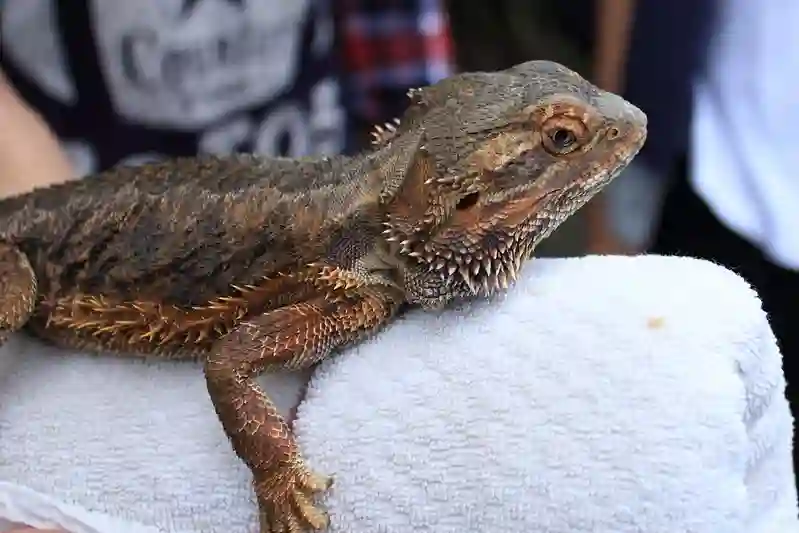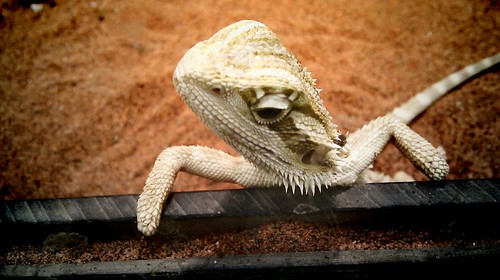Finding a lost bearded dragon can be a stressful and overwhelming situation. However, with the right approach, you can quickly find your beloved pet.
Start by searching in your home, especially in places your bearded dragon likes to hide, such as in dark corners, behind furniture, and near their food and water dishes. Once you have exhausted all the typical hiding spots, you can try using a flashlight to search in unseen corners, under furniture, and behind furniture.
Conduct a thorough search of your home and any nearby areas, such as your backyard, garden, and other areas your dragon may have decided to explore.
For more details, read the articles:
Search the Immediate Area
One of the most important steps you can take when searching for your lost bearded dragon is to start by searching the immediate area where they were last seen. This may be a room in your home or an outdoor area where your bearded dragon was last spotted.
Begin by looking under furniture, around corners, and behind objects. Bearded dragons often like to hide in small spaces, so check any nook or cranny that could be used as a hiding spot.
Don’t forget to look up too – bearded dragons are excellent climbers and may have found a perch on a high shelf or piece of furniture. You should also check for any openings or escape routes that your bearded dragon may have used to leave the immediate area.
This could include gaps in windows or doors, holes in walls or screens, or even larger openings like open vents or chimneys. Keep an eye out for any signs of scratches or scuffs that may indicate your pet has crawled through an opening.
If you are unsuccessful in finding your pet after thoroughly searching the immediate area, it’s time to expand your search to surrounding areas. However, make sure you’ve checked every possible spot before moving on.
Expand search to surrounding areas
After searching the immediate area, if your bearded dragon is still not found, it is time to expand your search. Look for adjacent rooms or other indoor and outdoor areas where the bearded dragon might have gone to hide.
If you have an outdoor enclosure for your bearded dragon, check it thoroughly as well. If you are searching outdoors, use a flashlight if it’s dark outside.
Be sure to look carefully in any place that might offer warmth or protection such as under rocks, logs, and bushes. It’s essential to check places where the bearded dragon could get trapped or stuck such as drainage pipes and air vents.
Use a flashlight if searching at night
If you are searching at night, using a flashlight can help you spot your bearded dragon more easily. Since they are cold-blooded animals and need heat from sunlight or heat lamps to regulate their body temperature, they may seek warmth in places that reflect light such as rocks or metal surfaces. When using a flashlight at night, avoid shining it directly into the eyes of any animals you encounter.
This can temporarily blind them and cause unnecessary stress. Instead, point the beam of light just ahead of where you’re walking so that you can see any obstacles on the ground without blinding anyone in your path.
Look for any signs of movement or tracks
If your bearded dragon has been missing for some time and isn’t responding to your calls or scent trails left by their favorite food items or clothing with familiar scents on it then looking for signs of movement may help locate them.
Bearded dragons tend to leave visible traces behind when they move around like scratches on walls or floors made by their claws while climbing around corners. You should also keep an eye out for signs of their tracks such as footprints, tail drags, or even marks made by their bellies while crawling around.
This can help you track where they have been and narrow down areas where they might be hiding. If you find any tracks or other signs of your bearded dragon’s movements, follow them carefully and cautiously to avoid alarming or disturbing them.
Utilize Scent Trails
The Power of Smell for Bearded Dragons
Bearded dragons have an excellent sense of smell, which makes utilizing scent trails a highly effective method for finding a lost bearded dragon. Their incredible ability to detect scents is due to the presence of chemoreceptors located in their nasal cavity.
These receptors can detect specific chemicals and help bearded dragons differentiate between various smells. To locate your lost bearded dragon, you can use their sense of smell to your advantage.
Luring Them Out with Familiar Scents
One way to create a scent trail is by using familiar smells that your bearded dragon associates with positive experiences, such as their favorite food or your scent. Place their favorite food near their hiding spot, and the aroma will attract them to come and investigate. If they recognize the scent and find the source of food, they may stay there until you find them.
Another option is using an item that has your scent on it like clothing or bedding. Bearded dragons are known for forming strong emotional bonds with their owners, which means they are sensitive to familiar scents.
Placing items such as used clothing or bedding near the hiding spot can prompt them to come out and investigate. When creating a scent trail, ensure that you only use safe items that won’t harm your pet reptile if ingested or touched.
Avoid using artificial fragrances like perfume as this could irritate your pet’s respiratory system and cause more harm than good. By utilizing scent trails effectively, you will increase the chances of locating your lost bearded dragon quickly and safely.
Set up traps
If your bearded dragon has been missing for a few hours and you haven’t had any luck finding it through a search, it may be time to set up some traps. A simple trap that you can make yourself is by using a cardboard box with holes cut into it and place food inside.
Make sure that the holes are big enough for your bearded dragon to fit through but small enough to prevent other animals from entering the trap. You can use different types of food as bait, depending on what your bearded dragon likes.
Many people find success with live insects such as crickets or mealworms, while others prefer fresh fruits or vegetables. Place the trap in an area where you suspect the bearded dragon may have gone and wait for it to take the bait.
Create a trap using a cardboard box with holes cut into it and place food inside
When setting up the trap, make sure that there is no direct sunlight shining on it as this could cause overheating. You should also check on the trap frequently so that if you do catch another animal that isn’t your bearded dragon, you can release it unharmed.
If you are concerned about leaving traps outside overnight due to cold temperatures or potential predators, consider setting up indoor traps instead. Use plastic containers instead of cardboard boxes to prevent moisture damage, and make sure there is adequate ventilation for any animals caught in them.
Check frequently and release any non-target animals caught
It’s important to check on any traps frequently so that if you do catch another animal that isn’t your bearded dragon, you can release it unharmed. Remember not to leave trapped animals unattended for long periods of time as they may become stressed or dehydrated. If you do catch your bearded dragon in one of the traps, be sure to approach it calmly and gently.
Use a soft towel or cloth to pick up the bearded dragon and place it back into its enclosure. It’s important to monitor your bearded dragon for any signs of stress or illness after its ordeal.
Setting up traps is just one way to find a lost bearded dragon, but it can often yield positive results. Remember to remain patient and persistent in your search, as well as keeping an eye on areas where your pet may have wandered off to.
Ask for help from neighbors and social media
Reach out to neighbors and ask them to keep an eye out
When searching for a lost bearded dragon, it’s important to enlist the help of others. Reach out to your neighbors, letting them know that your pet is missing and asking them to keep an eye out for any signs of movement or sightings. If possible, provide them with a photo of your bearded dragon so they can easily identify it.
Utilize social media platforms
Social media platforms such as Facebook, Twitter, Instagram, and Nextdoor can also be powerful tools when searching for a lost bearded dragon. Create a post describing the situation and include a clear photo of your pet along with any relevant information such as the date and time it went missing, its name, and any special markings or characteristics.
Encourage people in your community to share the post with their own networks. By using social media platforms in this way you’ll increase the chances of finding your beloved pet by reaching thousands of people who will help spread awareness about its disappearance.
Conclusion
Losing a pet can be devastating but there are steps you can take when trying to find your lost bearded dragon. Act fast by searching thoroughly in the immediate area where it was last seen before expanding your search into surrounding areas. Use familiar scents like their favorite food or clothing with your scent on it to lure them out of hiding spots.
Set up traps nearby including cardboard boxes or humane traps baited with food. Don’t forget about asking for help from friends, family members, neighbors, or even social media communities online!
The more people you have looking out for your beloved reptile pal means more eyes scanning areas where they may have wandered off to. By persistently following these tips above there’s still hope that your scaly friend may return back home safe and sound.


